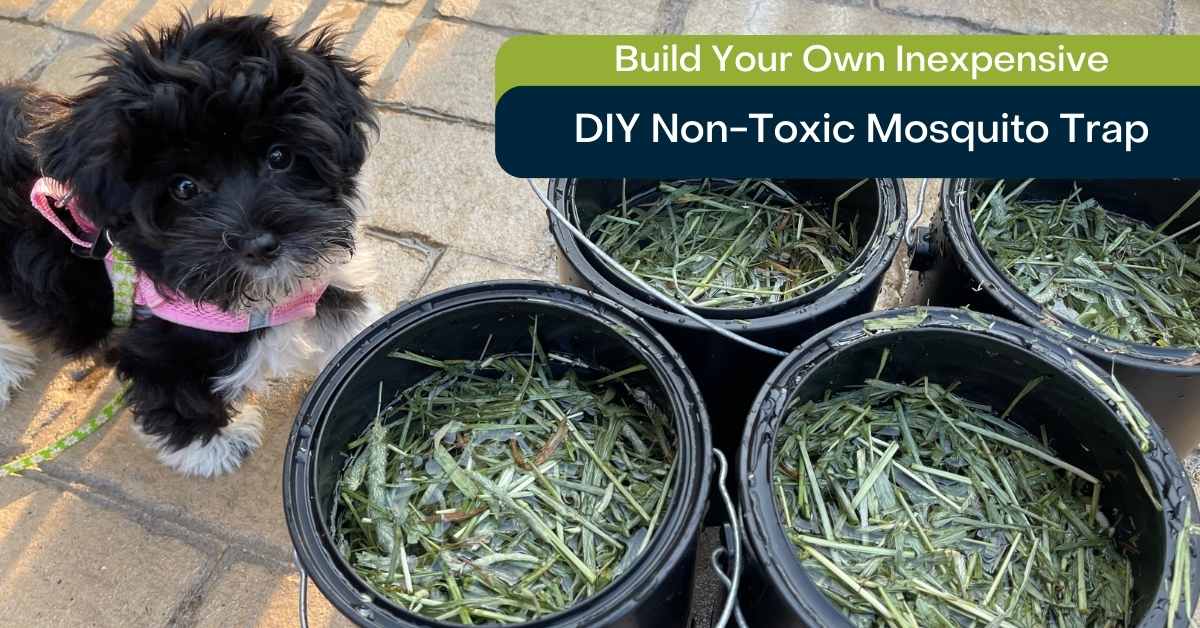DIY Non-Toxic Mosquito Trap That is Safer than Mosquito Yard Treatments
Pet parents have valid concerns about mosquitos.
They can spread heartworm and other infections (parasitic, viral, and bacterial). And... let's face it. They are just annoying!
While many pet parents are finally starting to understand the direct correlation between yard treatments and canine cancer, hormone disruption, and other health issues, there is still a huge disconnect between mosquito treatments and their long term dangers to you, your pets, other insects, and birds.
Many people think the mosquito treatments only kill the mosquitos.
That is just not true.
Mosquito treatments have to be applied at such high concentrations to effectively kill mosquitoes that they kill all insects.
In one study, Dr. Doug Tallamy, from the University of Delaware, cited that one of the most popular commercial mosquito sprayers (see study for the name of the company), only kills 10% of mosquitos per each spray which is why they have to continually come back to spray.
Spraying for mosquitos is ineffective, expensive, and not environmentally friendly.
Further, if birds eat insects that are sprayed, the build-up of toxicity in their bodies will have a long term impact on their health as well. The runoff of contaminated rainwater is also toxic to fish and small aquatic organisms.
Some common ingredients found in mosquito treatments that can be harmful include:
-
Pyrethroids: Pyrethroids (synthetic versions of pyrethrins) are synthetic insecticides commonly used in mosquito control products. They are toxic to cats and dogs and may cause drooling, vomiting, tremors, seizures, and more.
-
Organophosphates: Organophosphates are another class of insecticides used in mosquito yard treatments. They can be toxic to dogs and may cause symptoms such as excessive salivation, diarrhea, vomiting, muscle tremors, weakness, and in severe cases, seizures or respiratory distress. They have also been linked to lymphoma and leukemia.
-
Permethrin: Permethrin is a commonly used insecticide that is toxic to insects - including beneficial insects. Synthetic permethrin pose a toxicity risk to dogs. Dogs are particularly sensitive to synthetic permethrin which can lead to symptoms like drooling, tremors, seizures, and skin irritation.
-
DEET: While DEET is more commonly found in personal insect repellents, it may also be present in some mosquito yard treatments. DEET can be toxic to dogs if they ingest or come into contact with products containing high concentrations of this chemical. Symptoms of DEET toxicity in dogs include drooling, vomiting, muscle tremors, difficulty walking, and seizures.
Years ago we watched this video by Dr. Tallamy that changed how we fight mosquitoes.
Jill Spohn, at the Audubon Society of Northern Virginia tried Doug's trap and found it very effective.
Jill said in her review for the Audubon Society of Northern Virginia, "changing the strategy for controlling mosquitos is necessary because beneficial insects such as bees and butterflies and their larvae are being eliminated at an alarming rate. Insects are at the base of the food chain and, without them, birds and other creatures that rely on insects are challenged to find enough food for themselves and their young. When they eat sprayed insects, the insecticide can build up and affect their health."
It must also be noted that the cost of this DIY trap is SIGNIFICANTLY less than a company who comes to treat your yard every month with toxic chemicals.
Most importantly, it is effective and safe for you, your pets, beneficial insects, birds, and aquatic life.
Years ago we tried out the mosquito larva trap Dr Tallamy recommended and tweaked it to make it even better!
What you need:
- A black 1 gallon bucket
- A black lid for your bucket
- A drill with drill bit (to make holes in the lid)
- Straw (3-4 cups)
- Water (rain water is best but hose water will work too)
- 1/2 a Mosquito Dunk (which are non-toxic to humans, pets, and other insects like bees)
Instructions
- Drill holes in the lid so the mosquitoes can get into the bucket but your dog or other animals can't get into it
- Fill the bucket 1/2 with rain water (or tap water if you don't have any rain water saved up)
- Add some straw to the bucket (about 1 cup of stray per 4 cups of water)
- Let it sit in the sun for @ 3 days (long enough for it to ferment)
- Add 1/2 a mosquito dunk (too much and Dr. Elmer Gray, an entomologist at the University of Georgia, said it is less likely females will deposit their eggs there. According to studies, the Dunk is still effective cut in half)
- Cover with your lid
- Place it in a location where you see mosquitoes
- Set a reminder on your calendar to make a new trap about every 3-4 weeks as the dunks will only last about a month
This trap will kill the mosquito larvae laid by the female mosquitoes and over time, very effectively (and safely), reduce the mosquito population in your yard!
What Does Your DIY Mosquito Trap Cost?
Cost of your mosquito trap for the season (based on our costs):
- 4 qty - 1 gallon containers with lids: $31.99
- 6 Mosquito Dunks (we got 2 6-packs for the full season) $10.47 each- $20.94
- 1 bail of straw $6.68 (We used a small bail of Timothy Hay which cost a little more... but that is what we had on hand)
Total Cost: $59.61
That is less than the cost of 1 application from a mosquito treatment company and it is MUCH safer for you, your pets, bees, birds, and the whole planet!
Some notable facts about mosquitoes:
- Only female mosquitoes bite. Of the 200 types of mosquitoes in the US, only 12 types bite and can spread disease.
- Mosquito larvae only survive in water.
- Wearing white or light colors you are less likely to be bitten by a mosquito. Mosquitoes are attracted to dark colors, as they provide greater contrast against the surrounding environment. Dark colors also tend to retain more heat, which mosquitoes are drawn to. Light colored or white clothing, on the other hand, reflects light and heat, making it less attractive to mosquitoes. Additionally, lighter colors are less likely to provide the same visual contrast that mosquitoes seek when searching for a blood meal. Of course, wearing light or white clothing may help in reducing mosquito bites, it is not a foolproof method. Mosquitoes are attracted to various factors such as body heat, carbon dioxide, and certain scents emitted by individuals.
- Mosquitoes are more active during a full moon and are otherwise most active in the early morning and at dusk.
- Mosquitoes have been around since the Jurassic period, making them over 210 million years old!
- Mosquitoes often stay within several hundred feet of where they were hatched for life.
- Sweat helps mosquitoes choose their victims.
- A mosquito has an average lifespan of 30-40 days.
- Mosquitoes can breed in tiny amounts of water and lay up to 300 eggs at a time.
- Certain scents can confuse mosquitoes (like mint and Cedarwood essential oil).
- The mosquito saliva is what leaves the itch and bump on your skin.
- Mosquitoes are considered the deadliest animal in the world because they cause more death than any other animal on the planet through Dengue fever, yellow fever, heartworm, malaria, West Nile fever, Zika virus, encepahalitis, and more.
- Removing any standing water in your yard will help to reduce the mosquito population around your yard as mosquitoes lay eggs near water. Once a week, empty and scrub, turn over, cover, or throw out any items that hold water like buckets, planters, toys, pools, bird baths, flowerpot saucers, or trash containers.
Mosquitoes are more than just an annoyance and finding safe, effective ways to control them without harming yourself, your pets or the environment of other beneficial insects is an important thing to do.
Let us know how this works for you!
Happy Summertime!





